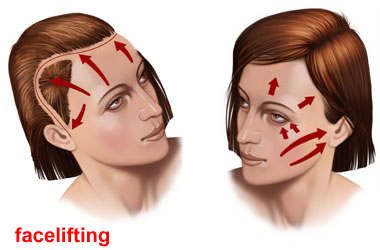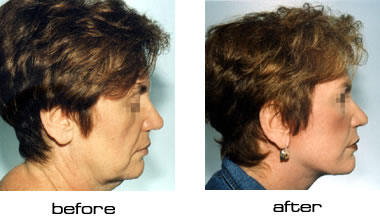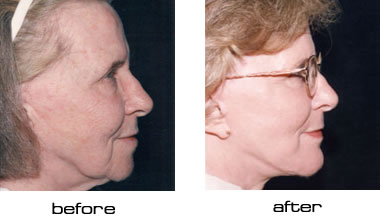Cosmetic surgery facelifts or Rhytidectomy (incl. 3 day facelift)
Rhytidectomy (Face Lift)
Rhytidectomy, also known as a facelift, is a plastic surgery procedure in which all the excess fat between the nose and mouth is removed, and the underlying muscles are tightened. This treatment does not stop the aging process. There is a reason it is called a "face lift". The facial skin is literally lifted off the face, and the surgeon tightens the skin tissues underneath, and then repositions the tightened skin over the face.
Here is a picture , how it happens.

The right candidates for the Rhytidectomy are those people whose face and neck start to sag, but also have an elastic skin and a strong bone structure.
What to expect during and after a face lift procedure
If you are planning to get a face lift, expect massive anesthesia. The face-lift surgery will usually take several hours – especially if the surgeon is removing fat from your skin. Do not worry too much about scarring, because the incision will be made on the hairline, where it is less noticeable. It is advisable to spend at least one day in the hospital after a face-lift.
Cosmetic Surgery Face Lift (Rhytidectomy) Procedures
Traditional face lift - A typical face lift, performed under anaesthetic, involves the surgeon making a surgical cut right around the hairline, past the front of the ears. Cuts may also be made under the chin, to lift a sagging jaw line. The skin will then be separated from the underlying muscles of the face. Excess fat will be removed and the muscles will be tightened. The skin will then be lifted up, pulled back and any excess will be trimmed off. It will then be stitched back to the line where the cut was initially made.
Another option is a face lift using keyhole (endoscopic) surgery, mainly for a brow lift (where the forehead is lifted). Several tiny cuts are made that allow an endoscope to be placed under the skin. The operating instruments are inserted through other tiny holes. The surgeon watches a TV monitor to see what he is doing under the skin.
Another type of face lift surgery is minimal access cranial suspension (MACS). Shorter cuts, compared to a traditional face lift, are made in the temple and in front of the ears. Fibrous tissues under the skin are tightened with permanent stitches that are fixed to tissue close to the cheek bone or the fibrous connective tissue under the skin.
Both endoscopic facelift and MACS have the advantages of smaller scars and usually a shorter recovery time.
Risks of Cosmetic surgery facelifts or Rhytidectomy
Your body may react against the anesthesia. You could also get an infection, or possibly damage your facial muscles. Some patients experience bleeding under the skin, while others suffer from hair loss. Be sure to talk to your cosmetic surgeon about all these concerns before deciding to go under the knife.
For faster recovery after Cosmetic surgery facelift :
• Apply cold, dry compresses often
• Avoid nasal medications for 3 months
• Use humidifier and saline spray for 2 weeks
• Keep head elevated to reduce swelling
• Avoid blowing your nose for the first 4 weeks to reduce bleeding and abnormal healing
Pictures of successful cosmetic surgery facelifts or Rhytidectomy
Face lift before after pictures (photos)


Face lift cost
Face Lift Cost Range: $3,000 - $12,000
Average Total Cost: $4,500
Surgeons fee: $3,000
Anesthesiologist: $700
Facility fee: $800
Average cost by procedure:
Primary open rhinoplasty $3,152 - $6,500
Primary closed rhinoplasty $2,879 - $5,800
Primary Septoplasty/Turbinectomy $3,500 - $6,500
Secondary open rhinoplasty $7,000 - $9,000
Secondary closed rhinoplasty $2,643 - $10,000